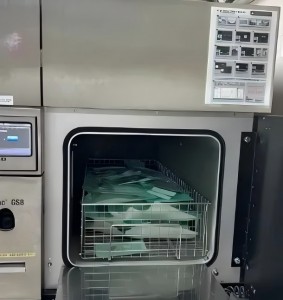The materials of medical devices can be roughly divided into two categories: metal materials and polymer materials. The properties of metal materials are relatively stable and have good tolerance to different sterilization methods. Therefore, the tolerance of polymer materials is often considered in the selection of sterilization methods. The commonly used medical polymer materials for medical devices are mainly polyethylene, polyvinyl chloride, polypropylene, polyester, etc., all of which have good material adaptability to the ethylene oxide (EO) sterilization method.
EO is a broad-spectrum sterilant that can kill various microorganisms at room temperature, including spores, tuberculosis bacteria, bacteria, viruses, fungi, etc. At room temperature and pressure, EO is a colorless gas, heavier than air, and has an aromatic ether smell. When the temperature is lower than 10.8℃, the gas liquefies and becomes a colorless transparent liquid at low temperatures. It can be mixed with water in any proportion and can be dissolved in commonly used organic solvents. The vapor pressure of EO is relatively large, so it has strong penetration into the sterilized items, can penetrate the micropores and reach the deep part of the items, which is conducive to thorough sterilization.
Sterilization Temperature
In the ethylene oxide sterilizer, the movement of ethylene oxide molecules intensifies as the temperature rises, which is conducive to its reaching the corresponding parts and improving the sterilization effect. However, in the actual production process, the sterilization temperature cannot be increased indefinitely. In addition to considering energy costs, equipment performance, etc., the impact of temperature on product performance must also be considered. Excessively high temperatures may accelerate the decomposition of polymer materials, resulting in unqualified products or shortened service life, etc. Therefore, the ethylene oxide sterilization temperature is usually 30-60℃.
Relative Humidity
Water is a participant in the ethylene oxide sterilization reaction. Only by ensuring a certain relative humidity in the sterilizer can the ethylene oxide and microorganisms undergo an alkylation reaction to achieve the purpose of sterilization. At the same time, the presence of water can also accelerate the temperature rise in the sterilizer and promote the uniform distribution of heat energy. The relative humidity of ethylene oxide sterilization is 40%-80%. When it is lower than 30%, it is easy to cause sterilization failure.
Concentration
After determining the sterilization temperature and relative humidity, the ethylene oxide concentration and sterilization efficiency generally show a first-order kinetic reaction, that is, the reaction rate increases with the increase of ethylene oxide concentration in the sterilizer. However, its growth is not unlimited. When the temperature exceeds 37°C and the ethylene oxide concentration is greater than 884 mg/L, it enters a zero-order reaction state, and the ethylene oxide concentration has little effect on the reaction rate.
Action Time
When performing sterilization validation, the half-cycle method is usually used to determine the sterilization time. The half-cycle method means that when other parameters except time remain unchanged, the action time is halved in sequence until the shortest time for the sterilized items to reach a sterile state is found. The sterilization test is repeated 3 times. If the sterilization effect can be achieved, it can be determined as a half-cycle. In order to ensure the sterilization effect, the actual sterilization time determined should be at least twice the half-cycle, but the action time should be counted from when the temperature, relative humidity, ethylene oxide concentration and other conditions in the sterilizer meet the sterilization requirements.
Packaging materials
Different sterilization methods have different requirements for packaging materials. The adaptability of the packaging materials used to the sterilization process should be considered. Good packaging materials, especially the smallest packaging materials, are directly related to the sterilization effect of ethylene oxide. When selecting packaging materials, at least factors such as sterilization tolerance, air permeability, and antibacterial properties should be considered. Ethylene oxide sterilization requires packaging materials to have a certain air permeability.
Post time: Jan-13-2025












